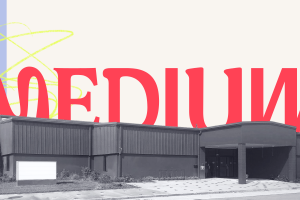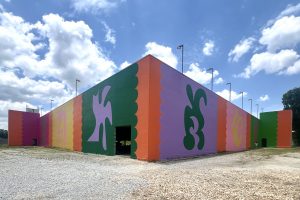Princeaus discusses their approach to songwriting

Nora B. aka “Princeaus”
Little Rock
Instagram: @princeaus.nora
Facebook.com/princeausmusic
TikTok: @princeaus
YouTube: Princeaus Official
Years of songwriting: 7
Editor’s Note: In our 2023 Music Issue, we spoke with musicians about how they approach different elements of a song during their creative process. We spoke with Nora B. and producer Andrew McClain about this.
Genre: Princeaus is experimental music that is genre-flexible. Genre placement is not a concern of mine when I’m writing about my emotions. With a midi keyboard or synthesizer I can create anything from techno, cinematic music, synthpop, to various shades of darkness. Life is fabulously chaotic, and if I’m pouring my soul into my art, then so will be Princeaus’ genre style. Andrew and I are a great team because we listen to different kinds of music. He likes more poppy and clean sounds, whereas I crave the harsh and gritty. Whenever you hear heartbeat drums that make you want to dance, or real clarity- that’s because of his drum capabilities and our combined brainpower to fine tune Princeaus’ music.
Melody: If a song starts off with a melody on the piano, either the lyrics will form around it or it will become an instrumental soundscape. If the lyrics are already in poem form and I have a wee tune in mind, the lyrics will dictate the flow of the song. “The Ideal Life” is an example of how melody doesn’t have to be written all at once. It began with me recording myself improvising on my midi keyboard. There were a few segments in the same key that worked together. As individual pieces, they weren’t intense enough. So I stacked those segments on top of each other, it formed a bolder melody, and the lyrics were written soon after. Every synth sound is the individual piano segments run through different synthesizers and filters. The vocal splices are different takes of the lyrics cut up and quilted together to form separate melodies that fit into the piece as a whole. Melodies don’t have to be straightforward. They can be cobbled together with bits and pieces of music.
Harmony: I began singing lessons when I was 7 and have spent 20 years of my life obsessing over vocal layering. Also coming from a madrigal choir background, I absolutely adore creating harmony. The tornado alarms that go off every Wednesday are very fun to harmonize with. Creating harmony is easier for me if I start with one note as my guide, and then find low and high harmonics for that note to glide on. When trying to find good notes to bounce and dance off the others- the main thing is just trial and error. Try to make parallel sounds that are velvety as an ensemble and organized in a way that pleases you. For me, moving in and out of bass and treble clefs helps me harmonize while keeping things balanced. Finding innovative ways to harmonize can be difficult. Micro-sampling my own vocals or simply making uneven oohs and ahhs is how I go about it.
Accompaniment: For all things piano or synthesizer, I handwrite and edit everything myself. I love this part of the creative process. When it comes to replicating classical instruments using electronic instruments, I tend to obsess over tremolo, note velocity, and timing. Making certain notes softer, or just a millisecond off can make them sound more realistic. Working with a midi keyboard, I can turn piano scores into anything and everything. With instrumental accompaniment, I have so much fun just playing around with different synthesizer tracks, layering them and creating entirely new soundscapes.
Song Structure: Song structure depends on whether the songwriting begins with lyrics or music. If I begin with lyrics in mind, the melody will follow that poetic style. I’ll already have an idea of the music I need to write. The structure is already mildly in place. A lot of Princeaus’ music begins with improvising on the piano, in which case I don’t begin with a specific structure in mind. Princeaus’ discography is a smorgasbord of different styles. I don’t think in terms of verse, chorus, bridge. Classical music doesn’t follow that pattern. It creates a storyline and soundscape. I try to stay in that realm of thought. I’ve been told many times that the way I compose is unique. Whenever I’m writing, I don’t really try to make any of my music sound similar. If anything, Princeaus’ discography is tied together by it’s unusual composition styles. Our lack of traditional structure is our form of consistency.
Lyrics: Each Princeaus song is it’s own snapshot into the mindset in which it was written. Within the lyrics, the way I describe about myself and my emotions is not always the kindest. This is intentional. When my poetry and lyricism is based around the subject of mental health, I will never be distracted by rose colored glasses. The lyrics in Princeaus’ music are my safe space for not being okay. My own personal underworld. My home away from home. If a song, “Night Crawlers” for example, is about extremely dark memories then I want the music to reflect that as much as the lyrics do. If the poetic subject matter is macabre, there’s no point in shying away from it. There’s no point in glorifying tragedy. But there is beauty is showing growth and how even if a poem is dark, the music shines through it. Like moss growing through a crack in the pavement.
Texture: The final part of my production process is panning and bringing the texture out of everything I’ve written. This involves hours of me listening to the same 4 measures over and over until driving myself to the brink of insanity. I honestly love this part of the process, that’s why I’m a bit over scrupulous. A good example of my tediousness is on Princeaus’ song “Medicine (Instrumental).” The track incorporates Andrew’s heartbeat sounding drums that I tried to parallel with vocal panning that is pulsing around the beat. Panning every instrument and track, including all drums, synths, and vocal tracks goes a long way to make a song feel more luscious.
Overall Song Arrangement: When I think of song arrangement, I’m reminded of my culinary background. Making good flavor profiles that have savory, sweet, and acidic notes is similar to songwriting. I try to make mixed-genre music that has different textures, but it has three main components in common: my voice, pianos/synthesizers, and Andrew’s drums. I can use those ingredients to make so many new creations. Finding a balance where the parts are great individually, but sound better as an ensemble can be difficult. It’s worth it to just spend time tinkering with the recipe until things taste just right to you.
Soul: What does all of Princeaus’ discography have in common? There is soul. Grief, despair, pain, chaos, harmony, sincerity, beauty, and hope. My music is a mirror. For me, soul comes from triumph, trauma, and tribulation. Inspiration can be found in rose petals as much as it can be found in the dirt in which the plant grows. My songwriting revolves around reflection and growth, as much as is revolves around darkness and grief. The soul in my music comes from depth of emotion. Princeaus illuminates my own chiaroscuro world.
Performance: Princeaus is an alter ego. Whenever I’m on stage, Princeaus is like a mask I put on to make myself feel bolder. At its core, it’s an emotionally raw and often harsh way of presenting my music to you. I truly dive straight into the darkest depths of my emotions for the audience. Submerging myself in the music as I swirl and twirl like a mermaid. In a theatrical sense, one might call it performance art. At this point, I have no idea what category Princeaus falls under. I d sing, dance, whisper, and scream at people while wearing wild makeup, sequins, and occasionally doing the splits. Take with that information what you will. I could be put on punk, electronic, hardcore, ambient, or experimental shows- but it all feels the same to me when I’m performing. It all feels like Princeaus. Holding a microphone under the glow of spotlights feels like home after a while. You can tell by how intense I am on stage that I’m having a great time and loving what I do! Being Princeaus is a bizarre job. I’m not quite sure what I’m doing. But I sure do enjoy doing it.
***
Andrew McClain
Little Rock
Genre: I think taking a genre-forward approach to music isn’t necessarily a bad thing; it can be a helpful jumping-off point for an individual song. However, I think the vast majority of artists find it restrictive in the long term and aspire to make music that transcends genre in some way – Princeaus included. I will say that I usually consider (or prefer) Princeaus’ music to be “pop music” in at least the roughest, broadest sense of the term, but Nora usually pushes against that – and that’s good, too – I think that friction makes Princeaus what it is.
Melody: Sadly not one of my gifts; I love a good, catchy melody and cannot write one.
Song Structure: I occasionally give notes on structure, texture, and overall arrangement when it comes to Princeaus – particularly when it comes to adding and subtracting certain elements at certain times to give them a little more impact. Often, this is just listening to a demo and saying “mute my drums at 1:42 and then bring them back at 1:57” or something. This is where my preference for a slightly more “pop” structure might come into play, but not to the extent of trying to force a verse/bridge/chorus where there isn’t one or anything like that.
Beat/rhythm: This is my wheelhouse. I have been using the program FL Studio for about nine years now and it is usually the starting point for any of my creative contributions to Princeaus and the couple of other music projects I’ve been a part of. FL Studio is the industry standard for hip-hop producers and has this very visual, kinetic, clean and modular aspect to it that other music software doesn’t, and it just makes intuitive sense to me. I feel like I was able to transfer my childhood Lego skills directly to FL Studio somehow.
For Princeaus, I combine and layer sounds from classic drum machines like the Roland 808, Korg Minipops, and Fairlight CMI, along with self-recorded samples like the clicks from a socket wrench or gas stovetop. I produce these drum tracks in small batches, exported at various BPM, and turn them over to Nora, who uses them in composition. This is our typical workflow, although we’ve been known to work backwards – like right now, actually, Nora has sent me a drum-less instrumental that I need to put drums over, which is simultaneously more fun and more challenging.





Comments